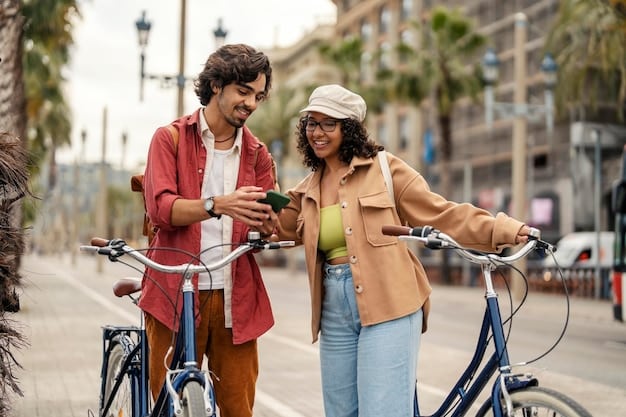Digital Nomad Transportation: US Travel Without Owning a Car in 2025

Digital Nomad Transportation in the US in 2025 presents diverse options for car-free travel, including leveraging public transportation, ride-sharing services, bicycle rentals, and strategic location choices near urban centers, offering cost-effective and environmentally conscious alternatives.
Embarking on a digital nomad journey in the US doesn’t necessarily mean being tied to car ownership. Understanding **Digital Nomad Transportation: Best Options for Getting Around the US Without a Car in 2025** is key to experiencing the country freely, flexibly, and often more affordably. Let’s dive into strategies that empower you to navigate the US without the need for a personal vehicle.
Digital Nomad Transportation: Embrace the Car-Free Lifestyle
The allure of the digital nomad lifestyle is often entwined with freedom and exploration. But what if you don’t want the responsibility or expense of owning a car? Thankfully, the US offers a growing number of transportation alternatives that cater specifically to the needs of tech-savvy wanderers. Let’s check some excellent available solutions.
Why Go Car-Free?
Opting for a car-free existence as a digital nomad has numerous advantages. Beyond the obvious environmental benefits, it can lead to significant cost savings, reduced stress, and even unique opportunities for socializing and engaging with local culture.
- Lower expenses related to car payments, insurance, maintenance, fuel, and parking.
- Reduced stress about driving in unfamiliar locations, traffic, and finding parking spots.
- Enhanced opportunities to discover communities and events through walking, biking, or public transit.
- Potential for healthier lifestyle through incorporation of physical activity into daily commute.
By consciously choosing to forego a car, you are positioning yourself to have better financial management, reduce stress, and be more physically active on a regular basis.

Mastering Public Transportation for Digital Nomads
One of the most budget-friendly ways to navigate the US without a car is mastering its diverse public transportation systems. From sprawling subway networks in major cities to regional buses connecting smaller towns, the options are more plentiful than many realize. Let’s explore this option in detail.
Decoding Local Transit
Every city has its nuances when it comes to public transport. Researching the best routes, purchasing the right transit passes, and understanding local etiquette is paramount to positive transit experiences.
- Download mobile apps that provide real-time information on bus and train schedules, disruptions, and optimized route planning.
- Consider purchasing weekly or monthly passes when staying in a city longer term to save substantially on transportation costs.
- Familiarize yourself with rider etiquette: yield to elderly or disabled riders, keep noise level low, and avoid spreading out personal belonging across multiple seats.
Becoming adept in integrating local transport is not just about practicality, but it contributes to a richer lifestyle by reducing dependence on individual automobile use.
Leveraging Ride-Sharing and Taxi Services
Ride-sharing services like Uber and Lyft have revolutionized the way people travel, offering on-demand transportation that bridges gaps where traditional public transit falls short. Taxis remain a classic option, especially during peak hours or in areas with spotty ridesharing coverage.
However, it’s important to use these services strategically and be mindful of expenses. Implementing the tips below helps optimize the usage of these resources without breaking the bank.
- Compare prices between ride-sharing services, taking advantage of surge pricing fluctuations and different fare structures.
- Try to schedule rides during off-peak hours when demand is lower and prices are more manageable.
- Explore taxi-sharing options or carpooling through rideshare apps to further decrease costs per trip.
Always prioritize safety: verify driver identity, check vehicle ratings, and share ride details with trusted contacts.

Explore with Bicycle and Scooter Rentals
Many US cities promote biking and scooter riding by providing rental programs that fit the lifestyle of digital nomads. These options can improve mobility, decrease travel times, and promote an active lifestyle.
Make the most of these rental services by adhering to a few important guidelines.
- Prioritize safety when operating shared bikes or scooters: always wear a helmet, respect local traffic laws, and remain mindful of pedestrians.
- Research municipal regulations around bike and scooter operations, including restricted zones, parking rules, and speed limits.
- Examine pricing models to discover the most economical options, assessing daily rates, monthly subscriptions, and pay-as-you-go plans.
Integrating bike and scooter use can foster independence while avoiding dependence on individual automobile use.
Relocating Strategically: Prioritize Walkable Cities
One of the most impactful strategies for navigating the US without a car is choosing to base yourself in walkable or transit-friendly cities that promote non-vehicular transportation. Prioritizing these locations allows you to conveniently fulfill your daily needs, whether you’re attending meetings, enjoying cultural events, or simply grabbing groceries.
Identify Nomad-Friendly Hubs
Use online resources and real-time reviews to analyze city walkability, safety, cost of living, and availability of amenities that align with your lifestyle and work preferences.
Consider these factors while choosing locations:
- Areas with high walk scores feature an array of shops, restaurants, parks, and entertainment resources within easy reach.
- Access to reliable public transit, including subway lines, bus routes, and light rail options, facilitates convenient connectivity.
- Areas with robust bicycle infrastructure, including bike lanes, shared cycling paths, and bike-sharing programs, promote an active lifestyle.
Be sure to research thoroughly because each neighborhood has its unique benefits and challenges.
Optimizing Travel Through Intercity Transit Networks
For longer distances, digital nomads can take advantage of robust intercity public transportation networks, including Amtrak train lines and nationwide bus companies like Greyhound and FlixBus. These options offer budget-friendly transportation, comfortable seating, reliable Wi-Fi, and attractive routes. Plan ahead to travel more safely at a low cost.
However, optimize the experience by keeping a few things in mind:
- Book tickets well in advance to secure seat reservations and gain access to competitive rates.
- Select routes that feature scenic stops, urban hubs, or convenient transfer points to diversify your experience.
- Pack necessary comforts: keep device chargers, entertainment options, snacks, and travel pillows easily accessible for longer trips.
Remember to remain vigilant about personal safety at stations and during transfers.
| Key Point | Brief Description |
|---|---|
| 🚆 Public Transit | Utilize buses, trains, and subways for cost-effective travel. |
| 🚕 Ride-Sharing | Opt for Uber or Lyft to fill gaps where public transit isn’t available. |
| 🚲 Bike Rentals | Rent bikes or scooters for convenient urban exploration. |
| 🚶 Walkable Cities | Choose accommodations in cities with high walk scores. |
FAQ
▼
Yes, many digital nomads successfully navigate the US car-free. Strategic planning, selecting walkable cities, and using public transport are essential to getting around.
▼
Utilizing buses, trains, and commuter rails tends to be the most cost-effective option. You can also get monthly/weekly passes that helps reducing costs.
▼
Use online resources like Walk Score, City-Data, and local city planning websites. These platforms break down details regarding walkability and amenities.
▼
Typically, ride-sharing services like Uber and Lyft are more economical. However, during periods of intense demand, costs can compete with or exceed taxi fares.
▼
Mostly, yes. However, it’s important to stay vigilant. Verify driver information, share ride details with a contact, and be aware of your surroundings in stations.
Conclusion
Mastering **digital nomad transportation** in the US car-free is achievable with proper planning and creativity. Embracing public transit, ride-sharing, bike rentals, and prioritizating walkable cities empowers you to enjoy flexibility, budgetary control, and environmentally conscious travel throughout the US.





